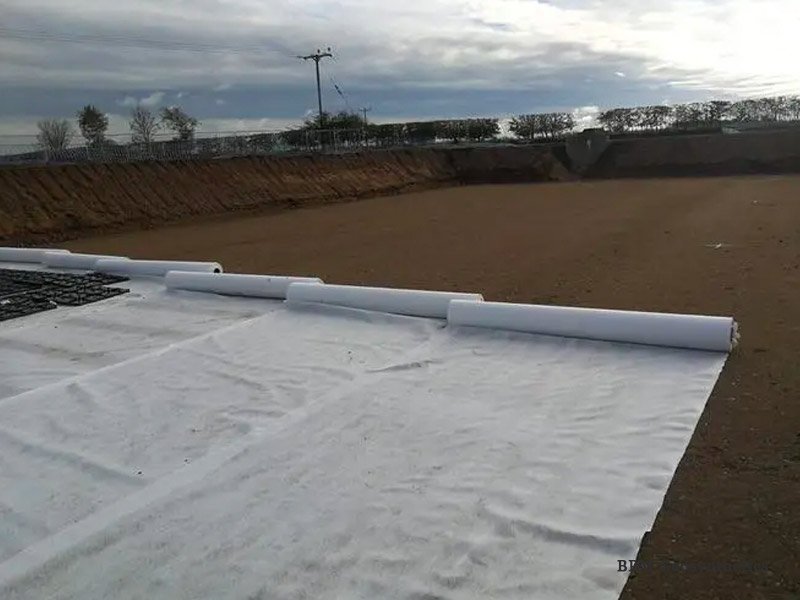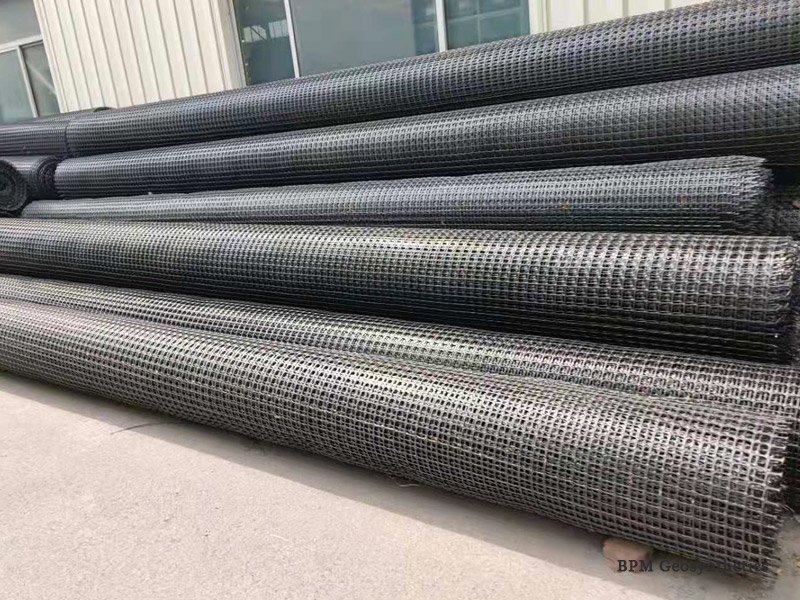Geogrid and geotextile are two common products and two common terms that often come up during construction plans or meetings. But what are they? Geogrids and geotextiles are both geosynthetic materials used in civil engineering and construction applications, but they have different functions and properties.
In this article we will explain in detail what is a geotextile, what is a geogrid and the difference between a geogrid and a geotextile.
1. What Is A Geogrid?
A geogrid is a type of geosynthetic material that plays a crucial role in civil engineering and construction projects. It is characterized by a grid-like structure consisting of interconnected tensile ribs with openings or apertures. These apertures are designed to allow the passage of soil, stone, or other geotechnical materials, enabling them to interlock with the geogrid.
The primary purpose of a geogrid is to reinforce and stabilize soil or aggregate. When placed within the soil, the geogrid acts as a reinforcement element, distributing loads and reducing the potential for soil movement or failure. By improving the soil’s strength and load-bearing capacity, geogrids enhance the overall stability and performance of various structures and foundations.
Geogrids are commonly used in a range of applications. In road construction, they are placed within the subbase or base layers to improve the pavement’s strength and resistance to rutting and cracking. Geogrids also find extensive use in the construction of retaining walls, where they provide additional support and prevent soil erosion.
Geogrids are employed in slope reinforcement projects to stabilize and reinforce the soil on steep slopes. By confining the soil particles and increasing their internal friction, geogrids help prevent slope failures and landslides.
2 What Are Geogrid Types?
2.1 What Is Uniaxial Geogrid
Uniaxial plastic geogrid is made of high-density polyethylene (HDPE) as raw material, plasticized and extruded sheets, punched, heated, stretched, extruded and pressed, the thin sheets are then punched into a regular hole network, and then vertically Stretched geogrid.
Generally used to lay in the soil, through the interlocking and interlocking effects between the grid mesh and the soil, an efficient stress transmission mechanism is formed, so that the local load can be quickly and effectively spread to a large area of soil. , thereby achieving the purpose of reducing local damage stress and improving the service life of the project.
2.2 What Is Biaxial Geogrid
Biaxial plastic geogrid is made of high molecular polymer through extrusion, plate forming and punching processes and then stretched longitudinally and transversely.
Biaxial plastic geogrid has great tensile strength both longitudinally and transversely. This structure can also provide an ideal interlocking system for more effective force bearing and diffusion in the soil, and is suitable for large areas. Permanent load-bearing foundation reinforcement.


3 What Is A Geotextile?
A geotextile is a versatile geosynthetic material that plays a vital role in civil engineering and construction projects. It is a permeable fabric typically made from synthetic materials such as polypropylene or polyester. Geotextiles are designed to enhance the performance of soil by providing various functions such as separation, filtration, reinforcement, protection, and drainage.
One of the primary functions of geotextiles is separation. When placed between different layers of soil or aggregates with varying particle sizes, geotextiles prevent mixing and maintain the integrity and stability of each layer. This is particularly important in road construction, where geotextiles separate the subgrade from the base or subbase layers, preventing the migration of fine particles and preserving the structural integrity of the pavement.
Geotextiles also serve as effective filters. They allow water to pass through while retaining soil particles, thereby preventing clogging and maintaining the long-term performance of drainage systems. By acting as a filter, geotextiles prevent the migration of fine particles into drainage pipes or geocomposite drains, ensuring their proper functioning.
Reinforcement is another significant function of geotextiles. By distributing loads and improving the tensile strength of soil, geotextiles enhance the stability and load-bearing capacity of structures. They are commonly used in applications such as retaining walls, embankments, and slopes to reinforce and stabilize the soil, preventing soil movement and failure.
Geotextiles also provide protection to geomembranes or other lining systems. When placed beneath a geomembrane liner, geotextiles act as a cushion, protecting the liner from punctures or damage caused by sharp objects or uneven surfaces.
Geotextiles facilitate drainage in various applications. They allow water to pass through while preventing the migration of soil particles, ensuring effective water flow and preventing the accumulation of excess water in the soil.
4. What Are Types of Geotextile
There are two types of geotextile including non woven geotextiles and woven geotextile.
4.1 Nonwoven Geotextile
Non-woven geotextiles are made of needle-punched polypropylene and can be used for separation and filtration at the same time. Nonwoven geotextiles combine the strength and high permeability of woven fabrics, making them a better choice for applications that require both separation and filtration.
4.2 Woven Geotextile
Woven geotextile is composed of woven and cut-film polypropylene material. This type of geotextile is made from two sets of parallel threads or yarns. Their combination of high strength and low permeability makes them very effective across wet or poor quality soils.
5 What Is The Differences of Geogrid and Geotextile?
5.1 Different Functions
Geogrids, made from strong polymers like polyester or polypropylene, reinforce and stabilize soil. With their grid-like structure and open apertures, geogrids distribute loads, improving the soil’s bearing capacity. These materials confine soil particles within their structure, enhancing shear resistance and internal friction, thus reinforcing the soil mass. Geogrids prevent soil movement, increase slope stability, and fortify structures like retaining walls. They are commonly used in civil engineering and construction projects.
Geotextiles, with their separation and filtering functions, provide water flow control and soil retention capabilities. These versatile materials are primarily used for separation, filtration, drainage, and erosion control purposes. Acting as a permeable barrier, geotextiles effectively separate different soil layers, filter water and contaminants, and create pathways for efficient drainage. Geotextiles play a crucial role in various civil engineering and construction projects where soil stability and erosion prevention are essential.
5.2 Design Differences
Geogrids have a rigid or semi-rigid structure, with intersecting ribs or nodes that create a three-dimensional grid pattern. This design allows them to withstand high tensile forces and transfer loads across a wider area.
Geotextiles have a fabric-like structure with a porous surface. They can be designed with different characteristics like permeability, filtration efficiency, and strength, depending on the specific application requirements.
5.3 Different Application
Geogrids are commonly used in applications such as retaining walls, embankments, reinforced slopes, road and pavement construction, and erosion control. They provide reinforcement and prevent soil movement or failure under heavy loads.
Geotextiles are extensively used in various applications, such as road construction, erosion control, landfill liners, subsurface drainage systems, shoreline protection, and sediment control. They provide separation between different soil layers, help with filtration and water flow, and prevent soil erosion.


6. How to Choose the Right geotechnical materials Between Geogrid and Geotextile?
6.1 Geotextile selection
Choosing the right geotextile material requires consideration of several factors, including project needs, soil conditions, type of project, and more. Here are some suggestions:
- Project requirements: First, clarify the specific requirements of the project, such as anti-seepage, reinforcement, isolation, etc. Different types of geotextiles have different performance characteristics in different projects. Ensure that the selected geotextiles meet the actual requirements of the project.
- Soil conditions: Consider the soil characteristics of the area where the project is located, including soil type, particle size, permeability, etc. Different geotextiles have different applicability to different types of soil. Choosing a suitable geotextile can improve the stability and effect of the project.
- Tensile Strength: Consider the tensile strength of the geotextile, which is an important indicator of its tensile performance. Select the tensile strength that meets the requirements according to engineering needs.
- Chemical resistance: If the geotextile will be affected by chemicals, such as in sewage treatment projects, it is necessary to choose a chemically resistant geotextile to ensure its good stability in a specific environment.
- UV stability: If the geotextile will be exposed to sunlight, its ultraviolet (UV) stability needs to be considered to ensure that it will not be damaged by UV rays during long-term use.
- Installation and Maintenance: Consider the difficulty of installing and maintaining geotextiles. Some geotextiles may require specific installation methods or regular maintenance, and these factors should also be taken into consideration.
Choosing a suitable geotextile requires comprehensive consideration of the specific circumstances of the project, and decisions are best made with the advice of a professional engineering designer or geotechnical engineer.
6.2 Geogrid Selection
There are several factors to consider when choosing a suitable geogrid:
- Requirements: First of all, it is necessary to clarify the specific requirements for the use of geogrids, such as anti-penetration, geological stability, anti-scouring and other functions.
- Material: Geogrids are usually made of plastic, polyethylene, polypropylene and other materials. The selection of appropriate materials depends on the requirements of the environment, such as corrosion resistance, UV resistance, etc.
- Strength and Stiffness: Select the appropriate geogrid strength and stiffness based on the required load requirements and geological conditions.
- Appearance: Select the appearance style and color according to actual needs and aesthetic requirements.
- Cost: Consider the cost of geogrids, including material costs, transportation and installation costs, etc.
- Manufacturer reputation: Choose a reputable geogrid manufacturer to ensure product quality and after-sales service. All BPM brand HDPE geomembranes have passed the certificates of the ISO9001, ISO14001, TUV, Soncap, SASO, BV certificates and passed the test of SGS and Intertek etc. Product innovation, quality assurance and customer satisfaction are our long term commitment to our worldwide customers .
7. Summary
The main difference between geogrid and geotextile lies in their primary functions and structural design. Geogrids are used for soil reinforcement and stabilization, while geotextiles are used for separation, filtration, drainage, and erosion control. Geogrids have a rigid or semi-rigid grid structure, whereas geotextiles have a fabric-like structure. Both geogrids and geotextiles play important roles in geotechnical and civil engineering applications, providing different functions to enhance the performance and durability of various construction projects.
How can we help you?
BPM Geosynthtics offers geogrids as well as geotextiles – our experts can advise on the best solution for your application.





